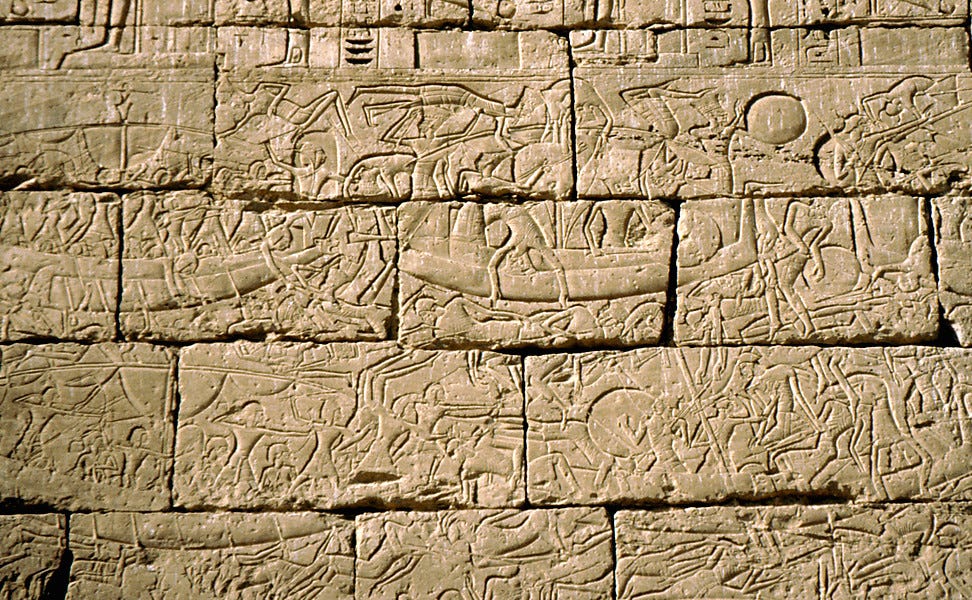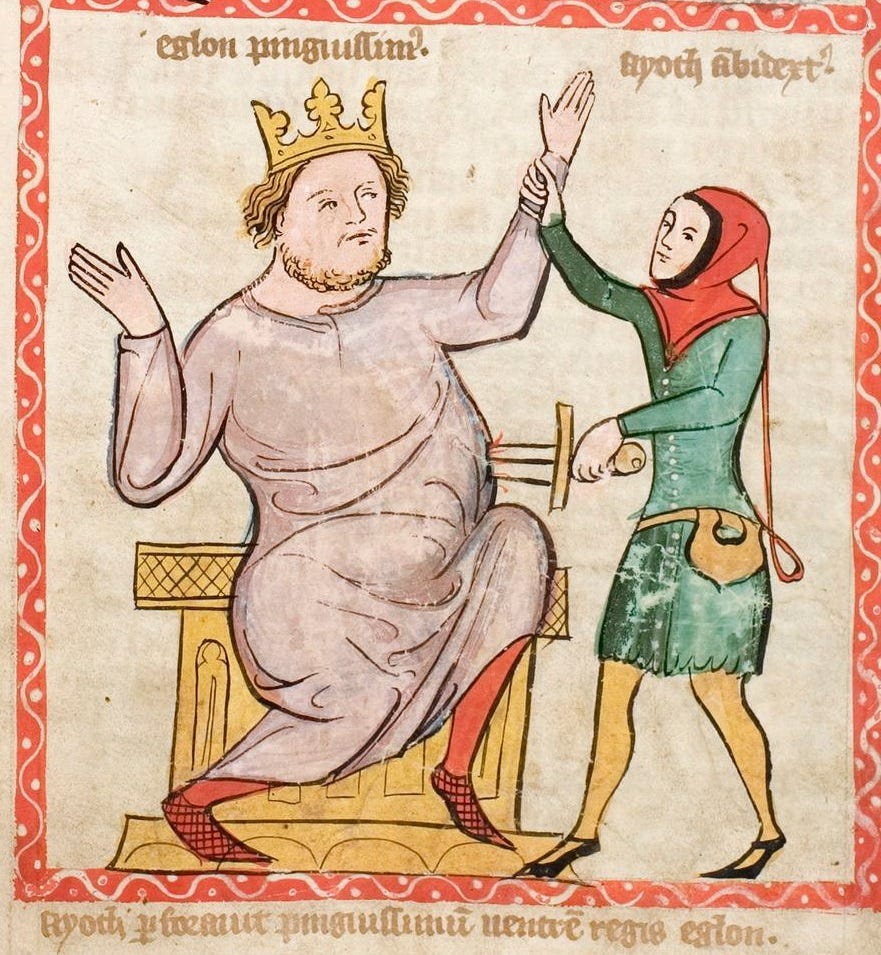Judges Chapter 3 Bible Study
The wicked king, the fat bull, and the Philistine slayer
This is part three of my Judges study. Read the previous parts here and watch for part four coming on March 20. Things are getting more interesting now that we are into the narratives centred on the judges, so I hope you enjoy learning more about these peculiar tales.
The third chapter of Judges is when the book moves from the introduction to the stories of the judges. It begins with a summary of the nations left in the land, naming the Philistines, Canaanites, Sidonians, Hivites, Hethites, Amorites, Perizzites, and Jebusites. These nations were specifically left as a test for Israel, but the Israelites ended up failing to obey God. They even intermarried with those who worshipped other gods, leading to an increase in idolatry in Israel. Interestingly, this is the first time in the book of Judges that the Philistines are mentioned. Known as one of the “Sea Peoples,” they were not native to the area and had a different material culture as a result.
The Bible records that the Philistines came from the Aegean region (Jeremiah 47:4), something that is also indicated by archaeological evidence.1 Philistine pottery shares many similarities with that of Mediterranean design, specifically in the bright colours used. These Sea Peoples originally sought to live in Egypt but were repelled by Ramesses III in the early 12th century BCE and instead settled in five cities along Israel’s southern coast that became known as the Philistine Pentapolis: Gaza, Gath, Ekron, Ashdod, and Ashkelon.2

Next, the text shifts to the story of the first judge, Othniel who was mentioned in chapter one. Verse seven describes the wicked behaviour of the Israelites in worshipping other gods, directly echoing what was predicted in 2:11. This angered the Lord and he sent King Cushan-Rishathaim (Cushan of double wickedness) of Aram-Naharaim to oppress them for eight years.3 His name is obviously not one given at birth but is meant to serve as a humorous title, indicating his disreputable character.4
Aram refers to the area northeast of the Sea of Galilee inhabited by the Arameans, while Naharaim, meaning “of the two rivers” is no doubt indicative of Mesopotamia.5 As for Cushan-Rishathaim, he cannot be identified with anyone from known historical records.6 Because the people chose to serve the deities of foreign nations, God gave them over to serve these nations.7 When Israel called upon God for help, he sent his spirit to come on Othniel who defeated Cushan-Rishathaim and established peace in the land for forty years. The “forty years” is probably not meant to be exact, since the Bible frequently uses the number forty to refer to an indeterminate long amount of time or a generation.8
One interesting thing that stands out about Othniel is his absence of negative traits. Not only does the order of the judges go from good to bad, but it starts in the south with the tribe of Judah and moves north as the book progresses. Othniel’s name means “God is my strength” and indicates to the reader that it was only through the power of God that he accomplished this feat.9
The cycle of Judges began again when the Israelites did evil in the Lord’s sight, though the specific evil acts they committed are not mentioned.10 A king of Moab named Eglon came to power and conquered Jericho, known here as the City of Palms, with the help of the Ammonites and Amalekites. Eglon’s name is the diminutive form of “bull” and sounds similar to the word for “round.”11 In fact, one could suggest his name as meaning “little fat bull,” a sort of ancient equivalent of calling someone a “fat cat.”12 We know from elsewhere that Jericho was destroyed during the time of Joshua and was not rebuilt until the reign of Ahab (1 Kings 16:34), meaning that Eglon’s fortress was only temporarily occupied and the city itself had not been repopulated.13
God chose Ehud to serve as a judge, someone called “a left-handed Benjaminite.” It could also be translated as “ambidextrous,” as the word is used in 1 Chronicles 12:2 to mean those who used both hands in shooting or slinging.14 There is also irony in the fact that Ehud was from the tribe of Benjamin, whose name means “son of the right hand.”15
Ehud was sent to deliver the tribute to Eglon, bringing a self-made sword with him hidden under his clothing. Hiding the sword on his right side allowed it to remain undetected by the soldiers and gave him the advantage of surprise since using one’s left hand to wield a weapon was abnormal.16 Tribute in the ancient world could be farm animals, precious metals, or produce.17 Upon presenting the tribute, he dismissed all those who carried the tribute and walked past the carved images near Gilgal. The word used for these sculptured images or stones is only used elsewhere in the Old Testament to refer to idols, lending credence to the idea that this site was one of cultic significance.18 Ehud’s choice to turn around by these stones could have even been intentionally done to make the king think that he had received a divine revelation and was returning to deliver it.19
After having returned, Ehud announced that he had a secret message for the king so he could be alone in the room with Eglon. In one of the Bible’s more gruesome stories, Eglon stood up from his throne only to have Ehud’s sword implanted in his belly. It was swallowed up by the fat and pierced his bowels, creating quite a mess. As stated by J. Clinton McCann, “In contemporary terms, figuratively and literally, Ehud beats the crap out of Eglon.”20 Ehud locked the doors and escaped, leaving the servants to assume that Eglon was on the toilet. The literal translation for “relieving himself” is “covering his feet,” which was a Hebrew euphemism.21 This thought could have arisen due to there being a strong stench of excrement from Eglon’s stabbing.22

When the servants unlocked the door, they found their king dead on the floor. Having wasted time waiting, they unknowingly allowed Ehud time to escape unnoticed. (An English teacher would probably say this is an example of dramatic irony or something.) Once Ehud reached Seirah in the hill country of Ephraim, he sounded a ram’s horn to summon the Israelites. Ehud then led the Israelites in battle and they defeated the Moabites, killing ten thousand. The Moabite warriors here are described as “stout,” drawing a comparison to their fat king.23

One recurring theme in the Ehud narrative is deception.24 Ehud conceals the blade under his clothing, lies to the king, and locks the doors all to deceive Eglon and his servants. Not only that, but it also looks as though he deceived the Israelites by keeping his plan to assassinate Eglon a secret.25 Additionally, the story portrays Eglon as a sort of sacrificial bull given his name, size, and vacuity.26
The use of the word hand occurs repeatedly throughout the text. K. Lawson Younger Jr. has compiled a list of each time the word appears which I have transcribed below.
3:15a Ehud is restricted in his right hand (yād)
3:15b The Israelites send tribute by Ehud’s hand (yād)
3:21 Ehud reaches with his left hand (yād)
3:28 Yahweh has given their enemies (Moab) into their hands (yād)
3:30 So Moab was struck down by the hand (yād) of Israel.27
The chapter closes with a brief note on one of the minor judges, Shamgar, who scholars agree was not an Israelite based on the origins of his name.28 He is called “the son of Anath,” which is the name of a Canaanite goddess and could indicate that he was one of her worshippers or be the name of his mother.29 Shamgar was known for killing 600 Philistines, and his weapon of choice, variously translated as “ox goad,” “cattle prod,” or “sharp stick,” was wooden with a metal point and used to control livestock.30
Judges chapter three covers three judges, a Judahite, a Benjamite, and a foreigner. Othniel begins the stories of the judges on a high note with his exemplary moral character, Ehud is a trickster who slays an oppressive king, and Shamgar remains somewhat enigmatic as little is known of his life. All of these men were used by God to accomplish his purposes and their heroic deeds continue to be retold.
BIBLIOGRAPHY
Block, Daniel I. “Judges.” In Joshua, Judges & Ruth, edited by John H. Walton, 198-451. Zondervan Illustrated Bible Backgrounds Commentary Series. Grand Rapids, MI: Zondervan, 2009.
Boda, Mark J. “Judges.” In Judges, Ruth, edited by Tremper Longman III and David E. Garland, 30-347. The Expositor’s Bible Commentary Series. Grand Rapids, MI: Zondervan, 2012.
Evans, Mary J. Judges and Ruth. Tyndale Old Testament Commentaries Series. Downers Grove, IL: InterVarsity Press, 2017.
McCann, J. Clinton. Judges. Interpretation: A Bible Commentary for Preaching and Teaching Series. Louisville, KY: John Knox Press, 2011.
Way, Kenneth C. Judges and Ruth. Teach the Text Commentary Series. Grand Rapids, MI: Baker Books, 2016.
Webb, Barry G. The Book of Judges. The New International Commentary on the Old Testament Series. Grand Rapids, MI: William B. Eerdmans Publishing Company, 2012.
Younger Jr., K. Lawson. Judges and Ruth. The NIV Application Commentary Series. Grand Rapids, MI: Zondervan, 2002.
Block, “Judges,” 240.
Ibid.
Webb, The Book of Judges, 159.
McCann, Judges, 53.
Block, “Judges,” 245.
Evans, Judges and Ruth, 71.
Webb, The Book of Judges, 158.
Way, Judges and Ruth, 58.
Ibid., 56.
Boda, “Judges,” 119.
Block, “Judges,” 248.
McCann, Judges, 55.
Webb, The Book of Judges, 167.
Block, “Judges,” 251.
Younger, Judges and Ruth, 116.
Boda, “Judges,” 122.
Way, Judges and Ruth, 65.
Webb, The Book of Judges, 169.
Ibid.
McCann, Judges, 56.
Way, Judges and Ruth, 67.
Webb, The Book of Judges, 172.
Younger, Judges and Ruth, 121.
Webb, The Book of Judges, 165.
Ibid.
Younger, Judges and Ruth, 119.
Ibid., 121.
Ibid., 130.
Webb, The Book of Judges, 175.
Ibid., 259.




